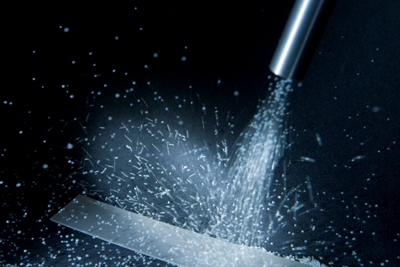Researchers have developed a new technique where small pellets are used to bombard the surfaces of distorted components to reshape them.
 Shot is fi red from a blasting gun at a ceramic leaf spring to correct its shape or cause specifi c warping as desired.
Shot is fi red from a blasting gun at a ceramic leaf spring to correct its shape or cause specifi c warping as desired.
Manufacture of thin ceramic parts is a costly and painstaking process as components tend to get distorted at the time of production and are thrown away as waste.
Metals lose their elasticity in high-temperature conditions, and beyond a certain temperature point, the properties of materials get affected. For instance, metallic springs stop functioning when heated over 500°C. However, when the same conditions prevail during a production process, the entire process can go haywire. One technique to overcome these issues is to produce components from ceramic, which is a strong yet lightweight material and also resistant to corrosion. The material can tolerate high temperatures. However, again, this provides only a partial solution as fabricating thin ceramics for components like mirrors for optical use and membranes for fuel cells and sensors is a complex process. The reason behind this is that expensive diamond tools are required to produce ceramics and the technique itself is not a practical option as it creates tensions within the material’s surface, which in turn distorts the end product the moment it is taken off the machine. Reshaping the components is not possible because the material is quite fragile. The significant amounts of waste produced from this process further escalate the costs.
Now, scientists from the Production Systems and Design Technology IPK in Berlin and Fraunhofer Institutes for Mechanics of Materials IWM in Freiburg have discovered a new way to reshape malformed ceramics by using a process called shot peening, wherein a blasting gun is used to fire tiny pellets at the component’s surface. The pellets bombard the surface and modify the shape of the material’s outermost layer. Scientists are able to produce concave mirrors from thin ceramic plates by moving the gun across the ceramic component along an accurate path.
The scientists have fabricated a concave mirror and a ceramic leaf spring, and the new method can be employed in series production. Furthermore, the IWM scientists are designing a PC simulation that will facilitate components to operate n various axes, while the IPK researchers are using a robot to automate the process.